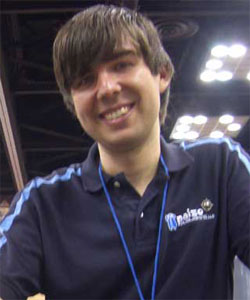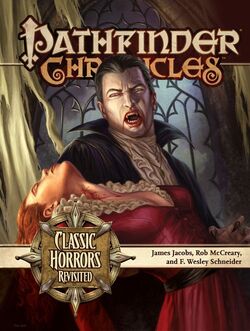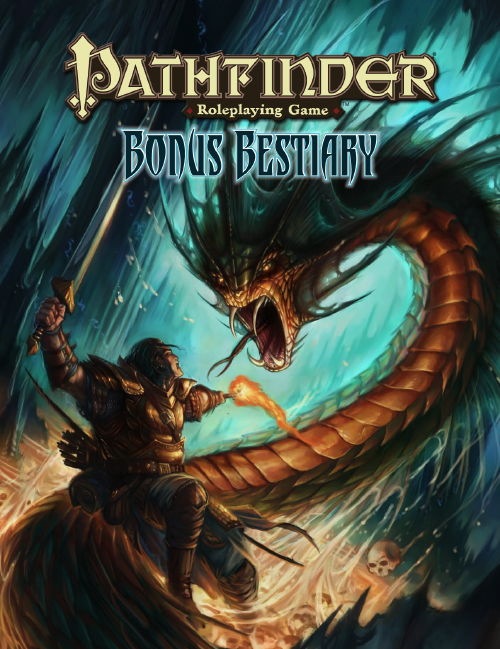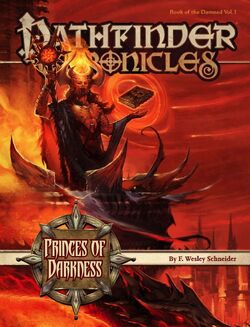With RPG titles like Classic Horrors Revisited (forthcoming from Paizo), Seven Days to the Grave (Paizo), and Cage of Delirium (Goodman Games), F. Wesley Schneider’s work clearly runs toward the dark.

Indeed, Schneider’s writing and his tastes are downright diabolical.
“In RPG terms, I’ve always been way more interested in devils than in other fiends,” Schneider said. “But at the same time, diabolical leaders and histories have traditionally paled in comparison to their demonic counterparts. Really, compare Demogorgon, Pazuzu, or—my favorite—Socothbenoth, to the archdevils who are pretty much just dudes with goatees.”
Schneider’s answer to this problem is the next entry in the Pathfinder Chronicles line, the Princes of Darkness—Book of the Damned, Volume 1 due out in August. Princes of Darkness promises vivid explorations of the nine levels of hell, more diabolical powers and many new infernal magic items.
As the Pathfinder managing editor, Schneider has had his hand in most things Pathfinder since its beginning. Below, Schneider talks about his work at Paizo, gives a few sneak peeks of the Combat Maneuver Bonus and a Combat Maneuver Defense, and obliquely mentions a very dangerous, very scary notebook.
Jones: It’s not all that long since you were freelancing. What’s it like being a “company man” these days?
Schneider: I’m actually coming up on my 6th year at Paizo, which, strangely, makes me like the sixth or seventh most senior staff member—that’s not saying a ton for a company that employs fewer than 25 people, but you get the idea. Time goes by pretty fast when you’re working in periodicals. Having worked on Dragon for several years and on Pathfinder since its inception, it has pretty much been a non-stop rush. We’re up against daunting monthly deadlines and every time we get through one we know it all needs to be done again for next month… and next month… and….

But really, it’s pretty awesome. As much as I loved getting to work with fantastic companies like Goodman Games, Sword & Sorcery Studios, Bastion Press, and numerous other great companies, I had always loved and wanted to write for Dragon magazine—so getting hired by Paizo back in 2003 was literally a dream come true. And now that we’re doing Pathfinder, I couldn’t be more excited, as we get to put out exactly the material we want for the games we love to play.
Jones: What role do you usually play in creative collaboration at Paizo?
Schneider: It wholly depends on the line. Pathfinder, first and foremost, is me and James’s baby. While James develops the adventure and writes the editorial most months, I tackle pretty much everything else. Aside from developing and editing the various world articles (like our gods series, ecologies, gazetteers, etc), the Bestiary (my favorite part), and all the other little bits throughout the book that need love (back cover, table of contents, preview, yada yada yada), I’m also in charge of ordering art, wrangling authors and outlines and making sure that the adventures and articles come in and are what we want them to be. That’s the daily grind stuff.
The most fun, though, usually happens around 8 or 9 o’clock on some random night when it’s just James and I left. Then, when we’re usually bleary eyed and punch drunk from the day, that’s when the phrase: “You know what would be a cool,” provokes conversations late into the night that turn into awesome monsters, books, and Adventure Paths. Pretty much every Adventure Path—and a ton of other products—have started that way, with the two of us just bouncing ideas off of each other when we’re the only folks in the office.
Outside of all that, there’s a constant buzz in the editorial pit, from questions about continuity and plots to grammar quandaries and layout issues. What a lot of that stuff comes down to, though, is a question of what’s cool. I tend to be one of the pickier editors here in that regard, so I get a lot run by me from the other lines. Even though my title is managing editor of Pathfinder, with such a small editorial pit ideas and influence are rarely compartmentalized and it’s really important to me that our world feel unified and universally interesting. And, overall, I think it does.
Jones: What parts of PFRPG do you feel are the most yours? Or, put differently, where is the Wesley Schneider footprint in PFRPG?
Schneider: In the Pathfinder RPG Core Rulebook itself, there’s not much I’d care to point to as my idea or my innovation. Really, so much work went into these rules—from the early days of 3.0, though our vast playtests, to the final days of editing—that there’s very little that is just one person’s idea of effort. This book really is an evolution of some of the best ideas to come out of the last decade of RPG gaming.
That being said, aside from participating in the nearly two years of discussions and playtests that went into this incarnation of the rules, I wrote a big part of the class descriptions and the vignettes starting each chapter (you’ll see what I mean in August).
It’s also really important to me that we stay aware of the roots of the game and the fantasies that inspired it, so I made sure we snuck in a sampling of some of the classics of fantasy into our suggested reading section—our own Appendix N—like Beowulf, Dracula, A Thousand and One Nights, and a few others.
Where you’re really going to see my hand is in the PFRPG Bestiary. Monsters have always been my favorite part of the game, and I’ve been steering the writing and development of the Bestiary for the past six months. It’s really coming together nicely, with some really fantastic art and more than 350 beasties (the same claim made by the first edition Monster Manual). There’s no losers in this book. Even some of the traditionally lamest-looking or -feeling monsters have gotten overhauls to either be more usable or just feel cooler in general.
Don’t expect broad reinterpretations of a lot of things, though, as first and foremost this book is meant to feel like a natural extension of the histories behind some of the oldest and most infamous creatures in fantasy gaming. But even some of your old least favorites are probably going to be worth another look.
We just got in the illustration for the hamatula—the barbed devil—for example, traditionally one of my least favorite fiends—and oh my gosh, between the new artistic interpretation and the text, I’m excited about this monster for the first time. There’s a lot of that going on in this book, not to mention tons of stuff to make using and running monsters way easier.

And, of course, you can get a preview of all this on June 20th with our fancy Free RPG Day offering, the Pathfinder Roleplaying Game: Bonus Bestiary.
Jones: How does the PFRPG system allow for more balanced encounters?
Schneider: Probably not the best thing to say coming from one of the editors of a book all about adventures, but personally I think the most interesting encounters are the unbalanced ones.
Take a beastie like the darkmantle or the salamander. A fair fight with these guys in a dungeon corridor is probably going to see them ruined. It’s when the darkmantle literally gets the drop on a PC or a salamander starts flinging lava from the middle of a lake of fire that exciting encounters happen. When the PCs can’t win an encounter by walking up and whacking away, when characters are forced to play smart or rely on a new strategy that, in my opinion, makes an encounter memorable. Even the highest damaging critical hit gets forgotten after a session or two—but climbing up to assassinate a lurking darkmantle or caving in the salamader’s lair, that gets remembered.
As for what the Pathfinder RPG does to encourage this, it gives you more. More character options, more feats, more skill uses, more combat options, all of that, and in a way that actually makes things more intuitive to run. Your wizard doesn’t need to be a fireball-flinger to be effective, your cleric doesn’t need to be a healer to be cool. It’s all about giving you the freedom to make the characters and choices you want.
With Pathfinder, I’m not going to buy the argument that someone didn’t get to do something they wanted because they played the wrong class or doesn’t have the right feat. Now the onus is much more on the player and his choices. Whether you make a fighter who can help cure a disease or create a cleric who can really pile on the magic damage, adventures are won or lost entirely by choices made in the moment, not at character creation.

Jones: Is Pathfinder sort of like the AD&D to the 4E Basic Set?
Schneider: Wow! Holy loaded question, Batman! Hum. Well. Pathfinder and 4E are totally different games, there’s no question about that. Folks across the interwebs have been zealously pointing out what they expect and perceive as merits and flaws of both systems for months now, and I’m sure that firestorm is going to get plenty of new fuel come August with the Pathfinder RPG Core Rulebook’s actual release.
Really, at the end of the day, though, it’s ridiculous to say Pathfinder players are experts and 4E players are novices. They’re both games—you play what you like and what you and your friends have fun with. Some folks like Settlers of Catan, some folks like Talisman—and arguing over which is the better game is kind of silly. Both have different rules and they do different things, but the end goal of getting you and your friends around a table to have a good time is the point. It’s the same with Pathfinder and 4E, and whatever you play, good on ya.
That being said, we made the Pathfinder RPG to be the game we want to play.
And most of all we wanted the Pathfinder RPG Core Rulebook to be a toolkit, one that lets us tell the stories we want to, whether our imaginings take inspiration from the classics of fantasy and science fiction or are wholly new stories we just dreamed up.
That really is the most important part…
Jones: What can we expect with next month’s Bonus Bestiary? Any changes from the Beta edition of PFRPG?
Schneider: Well, that’s our Free RPG Day offering this year and it’s a big preview of August’s Pathfinder Bestiary. In addition to a bunch of familiar monsters done up using Pathfinder RPG rules, there are details explaining what some of our changes to monsters, statblocks, and running characters in general.
Probably the most noteworthy bit that gets previewed in there are the rules for Combat Maneuvers, our answer to doing all the things you can do in battle that isn’t just your typical round of “I hit it with a sword.” Every character and creature now has a Combat Maneuver Bonus and a Combat Maneuver Defense. Your CMB is the bonus you have when attempting to do any sort of fancy fighting—like disarming, or grappling, or tripping, or what have you.
On the other side of things, every creature also has a CMD, which is essentially a DC based off of abilities, attack bonus, size and potentially a few other benefits, which together determine how difficult it is to pull combat maneuvers on.
These two simple calculations make some previously frustrating rules systems—like grappling in particular—really easy. Now, something like trying to disarm an opponent is just a matter of rolling a d20 and adding your CMB—and if the result exceeds your opponent’s CMD, its weapon goes flying. Easy!
There’re a few more specifics and options than that in the final rules, but that’s the gist. And you can read all about when you pick up the Bonus Bestiary on Free RPG Day, June 20th.
Oh, and the faerie dragon’s in there too.
Jones: The product description for Princes of Darkness promises a whole lot of… Hell.
Schneider: Of all the things I’ve ever written, Princes of Darkness is probably one I’m most excited about.

My goal with the whole book was to employ the tradition of not just the RPG vision of Hell, but also that seen primarily in classical and Abrahamic myth—as well as the stories of a dozen different cultures and authors—into a single unified, frightening and realistic vision of the scariest place in the multiverse. It meant a lot of research and actually ended up in the creation of a notebook that would probably get me excommunicated from any religion I might ever want to join, but ultimately it helped fashion something really cool.
So what to expect? Expect the first folio of the Book of the Damned, Golarion’s long-destroyed and scattered tome of ineffable evil. Along with pages of in-world histories and research into the nature of devilkind, there’s an exploration of each of the nine layers of Hell and the rulers of those realms. Expect new details on devils, how they live, what they want, and how to summon them. Lots of new diabolical powers, true names, diabolical sigils, devil talismans, infernal magic items, and blasphemous character options. There are several new kinds of devils and hierarchies of the diabolical elite, including dozens of infernal dukes, the revered whore queens, and those world-conquering Malebranche known to the diabolists of Golarion.
And—probably one of the parts I’m most excited about—a history of Hell that’s more than just a fantasy retelling of Paradise Lost.
On top of all this, the devil angle gets picked up in Pathfinder with the Council of Thieves Adventure Path, where we’ve got a lot planned, including a new devil in every volume, several articles on one of my favorite creations in Golarion, the Hellknights, and the first in a new series on the fiendish lords of our multiverse. I’m writing all of those, so it’s going to be a busy couple of months.
Jones: Do you have any non-Paizo projects you’d like to get to one of these days?
Schneider: Yeah, a vacation.
We’re happy to keep interviewing both the big guns and the Young Turks of the RPG field! If you’ve got a suggestion, let us know in comments.

OH WOW!
My birthday is in August, and Princes of Darkness might just be the best present I could imagine!
Devils are a favorite of mine, and I’m now completely sold on and stoked about both this and the next adventure path!
Great interview!
Rock! Good interview. :D
Yikes, can’t wait ’til august…
excellent interview, certainly I am waiting for Princes of Darkness and Gothic Horror Revisited… I suppose we would have to epster Wes with ideas on both :P
You rock, Wes! Thanks for doing the interview. I’m actually salivating right now.
Hey all! Thanks for the kind words! This was great fun and Jeremy was a fantastic sport. Always happy to ramble on about Pathfinder and scary monsters. Thanks for giving me the chance!
Long and long on details, very interesting – thanks Wes!